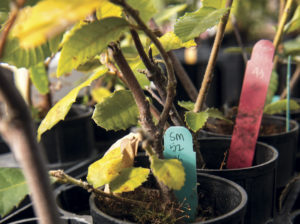Abundant rainfall in 2010 and 2011 was good for farmers, water districts, and wildflowers. It was also good for Phytophthora ramorum, the microbe that causes sudden oak death (SOD). But that was definitely not good for California oaks or the people who care about them, including nearly 500 Northern California volunteers who joined the fourth annual SOD Blitz last spring to help researchers track the oak-killing disease’s spread.
Citizen scientists will be out again this spring advancing a program conceived in 2007 by UC Berkeley SOD expert Matteo Garbelotto and Carmel Valley homeowners Jean and Jim Morrell. After attending a talk by Garbelotto, the Morrells recognized SOD’s potential to devastate their local landscape. Their idea, based on the “BioBlitz” model used in field science, was to train laypeople to identify SOD and then send them out to search for it.
-
Bay leaf samples are tested for sudden oak death pathogens at UC Berkeley. Photo by Doug Schmidt, UC Berkeley.
SOD Blitz volunteers look for infected California bay laurel trees. Although oaks are most harmed by SOD, they don’t spread the disease. SOD spreads to oaks via water droplets from other infected plants, most often bays (which aren’t killed by the disease).
Because bay trees in an area usually become infected before oaks do, bays can serve as an early-warning system. “It prioritizes where we really need to take action,” Garbelotto says.
SOD Blitzes have been conducted each year since 2008 from April to June, when late rains and warm weather increase the pathogen’s spread. After a short training meeting, blitz participants look for infected bay leaves in local forests or their own backyards and collect samples. Garbelotto and his colleagues analyze the samples to determine which bays harbor the pathogen and then map the results on their website and share the information at local follow-up meetings.
Volunteer Barbara West collected for the 2011 East Bay blitz in her Berkeley neighborhood, where backyards join in a forested canyon. “The canyon looked like it could be a reservoir of the disease because there are lots of oaks and bays,” West says. One of her leaf samples tested positive. This spurred her to look into protecting her oaks and to participate in future sod Blitzes. “I’m definitely going to do it again,” she says. “I like the notion of contributing something. I’m a wannabe scientist.”
Garbelotto says volunteer participation is crucial: “We don’t have the resources or the manpower to do this [with paid staff]. If we don’t take this on as private citizens, nothing else will take care of it. When problems are so large, they require community involvement.”
And the community is responding: Each year there are more local SOD Blitzes. In 2011, 500 volunteers in 16 blitzes collected samples from Monterey to Humboldt County. The results were dramatic: Rainy 2010 and 2011 produced marked increases in SOD infection in many blitz areas. In the East Bay, participants like Barbara West showed that the disease is moving from ridgeline parks westward down the hills. In the town of Napa, samples identified SOD on the valley floor for the first time. And in the Peninsula’s South Skyline neighborhood, a whopping 97 percent of samples tested positive, surprising even Garbelotto. “That tells me these people are very familiar with the disease. They know what to look for. But mostly it tells me it’s everywhere in that area.”
Knowledge of the distribution of the disease–and the ability to predict oak infections before they happen–is important for decision-makers of all kinds. Homeowners and neighborhood groups have taken steps to protect their oaks, including use of a preventive treatment, after finding SOD in nearby bays. And the San Francisco Public Utilities Commission, using the blitz to monitor its Alameda County lands, has enacted guidelines to prevent SOD spread by its construction projects.
For Garbelotto, the blitzes are essential for educating the public and controlling SOD’s spread. To those who care about oaks he says, “Look at the maps. If your neighborhood hasn’t been sampled, come [this] year and sample it.”
At matteolab.org, see SOD Blitz results and learn how to organize or participate in a blitz.

.jpg)




